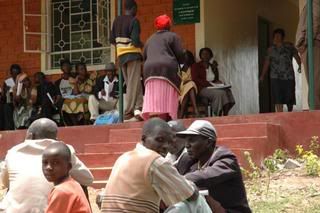The Clinic's Debut
Visiting a dentist or an eye doctor in the city of Eldoret costs the equivalent of $10. A pair of eyeglasses is typically about $45. The average Kenyan, in this area, makes $1/day and an average family can have between 5-12 children. The combination of low income and multiple mouths to feed often relegates medical attention to home remedies. They use blades of grass to remove bugs from their eyes and to relieve an eye infection they squirt the eye with breast milk.
Word had spread about the visiting team of eye doctors and the missionary team told us that we should expect to see many people and that these patients would come from villages near and far. The team was excited to begin treatments on Monday morning.
 The clinic opened at 8 a.m. and when the doctors arrived at 7:30, there was already a line of people, young and old, patiently waiting on the wooden benches outside. The front yard was littered with bicycles. Between 8-5, the optometry team served 135 patients—doling out roughly 120 pairs of glasses.
The clinic opened at 8 a.m. and when the doctors arrived at 7:30, there was already a line of people, young and old, patiently waiting on the wooden benches outside. The front yard was littered with bicycles. Between 8-5, the optometry team served 135 patients—doling out roughly 120 pairs of glasses.
From a rare ocular nerve disease, to untreated diabetes, to debilitating cataracts in the old, to advanced cornea disease in the young, children without eyes, foreign bodies, allergies, to just needing reading glasses, and, sometimes, just needing a little attention. The doctors treated as many patients as they could, as well as they could with the means available. The most striking thing about many of these patients was that their infirmaries, if caught earlier in the U.S., would be completely treatable—cataract surgery, cornea repair, diabetes medication, etc. Here in Kenya, however, these people would go blind.
Michele and Sharon also spent time with Kiptow—the resident nurse for the Kipkaren clinic. Kiptow does everything—delivers babies, treats malaria, administers AIDS tests, diagnoses ringworm, and much, much more. Both Michele and Sharon were amazed by the variety of pathologies presenting at this walk-in clinic on a hill, on a red clay road, through the corn and banana trees.
The Kipkaren Clinic is not a free clinic, but it is affordable to the poor. This is an important change that has occurred between Doc’s visit last year and this week. It costs 50 Kenyan shillings to visit the eye doctor at this clinic. That translates to 76 cents. Medications are not charged by the bottle, but by the number of types of medications that each patient receives: multiple bottles of 1 type of medicine costs 200 schillings ($3), 2 types of medicine 300 schillings ($4.50), reading glasses are 100 shillings, prescription glasses 200 shillings. It is a fraction of the cost of a downtown clinic, but the small cost creates two very important benefits in this Kenyan community. 1) it helps generate capital to sustain the badly needed Kipkaren Clinic, which even though it provided free services in the past, was not free to operate. 2) The Kenyan people may be poor in dollars, but they are rich in dignity. These people are not looking for hand-outs. They were proud to pay for the medicines and glasses. And, by providing a service that they paid for, they were more willing to get involved, have an opinion, select glasses that they liked, that fit well and improved their vision.



1 Comments:
Wow sounds like you are really busy there.
It is great to see the pictures of all of you and your patients.
Keep up the good work all is good here in Iowa.
A little storm last night came in to Solon, but I was able to talk with Liz and all is well. She said the puppies are well also.
Love to all
Henry's
Post a Comment
Subscribe to Post Comments [Atom]
<< Home